Reviews and recommendations are unbiased and products are independently selected. Postmedia may earn an affiliate commission from purchases made through links on this page.
Anthony Gismondi: The Cowichan Valley has become a special place for wine

The Cowichan Valley is Canada’s only ‘cool’ maritime Mediterranean climate with enough growing-degree days to support several vinifera varieties.
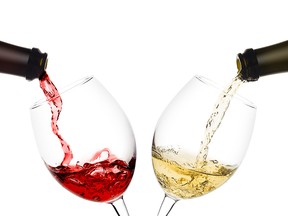
Article content
Blue Grouse Estate Winery and Vineyard has grown grapes in the Cowichan Valley for more than 25 years. Some varieties are lesser-known to mainstream wine drinkers, like Bacchus, Black Muscat, Ortega, Müller-Thurgau, Pearl of Csaba and Siegerrebe. In contrast, Pinot Gris and latecomers Pinot Noir and soon Chardonnay are destined to lead Vancouver Island into the next century and beyond.
Advertisement 2
Article content
The property was selected in 1977 as an ideal site to trial Vitis vinifera grapes by pioneering grower John Harper. Harper’s experimental vineyard featured 150 grape varieties, some still in production today. By 1988 the Kiltz Family purchased the vineyard and released the first Blue Grouse wines in 1990. Fast forward to 2011 and the arrival of the Brunner family, Paul, his wife Christina and daughter Paula, and the story of this magical site is only beginning.
The Cowichan Valley is Canada’s only ‘cool’ maritime Mediterranean climate with enough growing-degree days to support several vinifera varieties. So which grapes will put Cowichan on the same plane as Central Otago, New Zealand, Willamette Valley, Oregon, the Yarra Valley, South Australia or more local Okanagan Falls, East Kelowna, Carrs Landing or the Naramata Bench? At Blue Grouse, the answer is easy Pinot Noir and Chardonnay, and it’s reflected in all the plans and recent plantings moving forward.
Advertisement 3
Article content
Cowichan Valley is a special place with a real story about its dirt.
It all began when a sizable rocky land mass slammed into the west coast 100 million years ago. Owner Paul Brunner, a reformed mining engineer trying to make amends for his earlier sins, speaks about the big collision as the event that led to the birth of Vancouver Island. The land immediately began to erode for some 50-100 million years spreading sediment everywhere. Next, the weight of two-kilometre thick glaciers forced the lower portions of the land back under the Salish Sea sea. Finally, after the big melt, the ‘Nanaimo sediments’ and marine shells sprung back above sea level, forming the soils of Duncan and the area, not to mention the classic definition of terroir waiting to be mined by grapes.
Advertisement 4
Article content
Global warming continues to assist wineries on the eastern side of Vancouver Island to fully ripen their grapes with a high level of natural acidity. At Blue Grouse, the addition of first-rate viticulture practices under John Abbot has quietly taken the property organic, soon to be certified by the gold standard, European-based ECOCERT.
Enter winemaker Baily Williamson a transplanted chef whose creativity in the kitchen has followed him to the winery. Williamson has become a Pinot Noir crusader and will soon be a chardonnay maker. He will, however, continue to expound upon the charm and electricity of Vancouver Island Pinot Gris and his beloved Ortega.
The newest vineyard’s plantings are Chardonnay, Pinot Gris, Pinot Meunier and Pinot Noir, all of which speak to the future of Blue Grouse and how it will utilize its precious terroir. Paula Brunner represents the next generation at Blue Grouse. If everything works out, the family will be famous for Pinot Noir and Chardonnay and a method traditional sparkling wine made with Pinot Noir, Chardonnay and Pinot Meunier. The family has doubled its vines on the site to 35 acres and will double that number over the next three years as they further expand their vineyard lands across the street on the journey to create cru Vancouver Island wines.
Advertisement 5
Article content
Ambitious, you bet, but no one ever made it to the top by not dreaming. There is quiet, measured confidence at Blue Grouse and all over the Cowichan; like the once submerged valley, it is ready to rise to new heights, well above the waterline.
Like all Vancouver Island producers, it is best to visit the property to buy wine or at the very least join the wine club if you want access to the best wines. You will find all the details at bluegrouse.ca.
July 2022 marks the Brunner family’s first decade of wine growing at Blue Grouse, and they couldn’t be happier to welcome visitors back to the winery.
Weekend wine picks
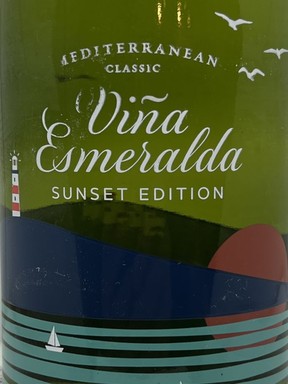
Vina Esmeralda Sunset Edition Moscatel — Gewürztraminer 2020, Catalunya, Spain
$15.49 I 89/100
UPC: 08410113001139
Advertisement 6
Article content
For decades, Vina Esmeralda has been a steady performer for the Torres family. The blend is Moscatel de Alejandría and Gewürztraminer, and the result is a medium-sweet, aromatic Mediterranean white with orange blossoms and mandarin on a creamy, highly spiced mid-palate. The finish, while short, is clean and fruit-packed. Serve cold with a favourite Thai curry.

Tohu Sauvignon Blanc 2021, Awatere Valley, Marlborough, South Island, New Zealand
$24.99 I 90/100
UPC: 9421003130012
Tohu is sourced entirely from vineyards located in Marlborough’s Awatere Valley. The nose has a fantastic aromatic effect that draws you into the glass. Orange, lemon grass, and passion fruit are all in balance, reducing the usual aggressive nose that can plague many Kiwi Sauvignons. The attack is equally well-balanced with more ripe, juicy, sweet mandarin, a dash of pink grapefruit, and a mineral, fresh citrus finish. The Awatere Valley is cooler, drier, and windier overall than other sub-regions of Marlborough, leading to an even longer growing season and a ripeness few can claim.
Advertisement 7
Article content
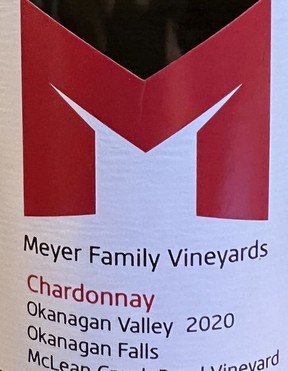
Meyer Family Vineyards Chardonnay McLean Creek Road Vineyard 2020, Okanagan Falls, Okanagan Valley, British Columbia, Canada
$32.26 I 91/100
UPC: 808755006809
In what has been described as a terrific year for Chardonnay in Okanagan Falls, you can look for a bright citrus, nutty, stony, mineral character that permeates, delivering just the right level of complexity to hold your interest throughout. It is all you could want for the price. Given all the worries about smoke taint in 2021, mainly over red wines involving skin contact in the south Okanagan, now is the time to secure a supply of top-flight 2020s to see you through next year.

Paul Mas Côté Mas Rosé Aurore 2020, Sud de France, France
$14.99 I 87/100
UPC: 3760040432113
Advertisement 8
Article content
If you are eager to kick off rosé season, let Jean Claude Mas help you out with his passion for the south of France and what he terms “Le Luxe Rural.” This litre-bottle of juicy, fruity rosé comes with a pale pink hue and bright strawberry, raspberry flavours that charm from the first glass to the last. A Grenache/Cinsault/Syrah mix has all the elements to turn a patio into a luxurious country setting. Fantastic value, too, in a one-litre package. Back up the truck.
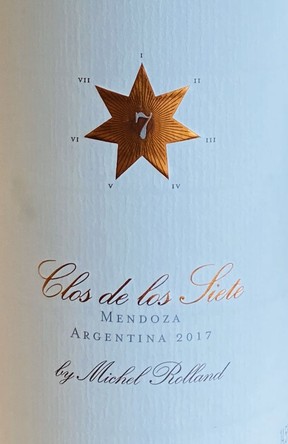
Clos de los Siete 2017, Valle de Uco, Tunuyán, Mendoza, Argentina
$27.99 I Score 91/100
UPC: 3258691254579
Michel Rolland, the world-renowned Bordeaux winemaker, partnered with other Bordeaux families to develop seven vineyards on 2,000 acres in the Uco Valley of Mendoza. The plan was to have an “ambassador” wine made with fruit drawn from across the project that Rolland would put together each year. Today Clos de los Siete is a blend of Malbec, Cabernet Sauvignon, Merlot, Syrah and a little Petit-Verdot and Cabernet Franc. The fruit is Uco, but the styling is all Bordeaux, and it is polished and elegant. It represents France and Argentina’s best, offering restraint and rich, powerful black fruit with a strong sense of terroir. The tannins are dense but supple and will only disappear as time slips away. It’s a delicious wine at a fair price that you need to decant at the moment or that you can cellar for five to seven more years until it reaches its peak.
Advertisement 9
Article content
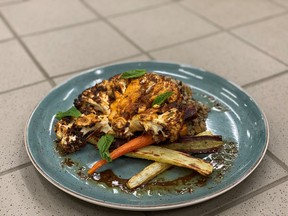
Recipe match: Cauliflower steak with Za’atar dressing
Created by James Kennedy, the executive chef of R+D Kitchen By White Spot, this flavourful entrée sees Middle Eastern and North African spices mingle for a “wonderful warming and balanced meal experience.” The gluten-free and vegan-friendly dish is a taste of what diners can expect from the innovative culinary destination at Amazing Brentwood in Burnaby, which aims to celebrate local chefs, farmers, brewers and more.
Cauliflower steak with Za’atar dressing
4 cauliflower steaks, approximately 1.5-inch thick
3 tbsp (45 mL) Harissa paste
1 tbsp (15 mL) olive oil
1/2 tsp (2.5 mL) kosher salt
1/2 tsp (2.5 mL) coarse black pepper
Carefully cut the cauliflower into even steak-like slices measuring approximately 1.5 inches thick, depending on the size of the cauliflower. In a small bowl, combine Harissa paste, olive oil, kosher salt, black pepper to make a glaze. Brush both sides of the cauliflower steaks with the harissa glaze and set aside.
Advertisement 10
Article content
Za’atar dressing
1/2 cup (125 mL) olive oil
1/4 cup (60 mL) red balsamic vinegar
1 tsp (5 ml) Za’atar spice
2 tsp (10 mL) chopped roasted garlic
1/4 tsp (1 mL) kosher salt
In a separate bowl, combine all dressing ingredients and whisk together. Make ahead of time and allow flavours to marry for 2-3 hours.
Ancient grains and lentils
2 cups (500 mL) Floating Leaf 6 Grain Prairie Blend, or use your favourite rice or grain blend cooked according to the package instructions
3 1/4 cups (810 mL) water
1/2 tsp (2.5 mL) kosher salt
1/2 tsp (2.5 mL) coarse black pepper
Mix all ingredients in a medium pot and bring to boil, reduce heat to simmer, cover and cook for 15-20 minutes. Remove from heat and allow to sit covered for 10 minutes.
After the grains rest for 10 minutes, mix in 4 oz of Za’atar dressing, reserve the remainder of the dressing to drizzle on the plate. The grains are served warm.
Advertisement 11
Article content
Final cooking & plating
Place the harissa-brushed steaks on a silicon paper lined or lightly oiled baking tray. Bake at 400 F for 15 minutes, then flip the cauliflower over and bake for 5 more minutes until cooked through and lightly charred. Remove from oven and keep warm. Place one generous cup of warm grain/dressing mixture on the plate. Lean the cauliflower steak against the grain mixture. Drizzle 1 tablespoon of the reserved dressing around the plate. Garnish with fresh mint leaves. Can be served with your favourite oven-roasted carrots.
Serves 4.
Recipe match
Cauliflower steak with Za’atar dressing sounds like a dry white wine but tastes more like Gamay or fruity Rose.

Haywire Gamay Noir Rosé Secrest Mountain Vineyard 2020, Summerland, Okanagan Valley $23.99
Wild strawberries and Rainier cherries seasoned with sagebrush and a cool, stony, saline finish are a match for adventure seekers.

Orofino Vineyards Gamay 2020, Cawston, Similkameen Valley $22.65
Juicy, berry fruit, spice, and wild Similkameen underbrush make this the perfect foil for the Za’Tar flavoured cauliflower.
More news, fewer ads, faster load time: Get unlimited, ad-lite access to the Vancouver Sun, the Province, National Post and 13 other Canadian news sites for just $14/month or $140/year. Subscribe now through the Vancouver Sun or The Province.
Source: vancouversun.com


